
A trolleybus is an electric bus that draws power from dual overhead wires using spring-loaded trolley poles. Two wires, and two trolley poles, are required to complete the electrical circuit. This differs from a tram or streetcar, which normally uses the track as the return path, needing only one wire and one pole. They are also distinct from other kinds of electric buses, which usually rely on batteries. Power is most commonly supplied as 600-volt direct current, but there are exceptions.

The Southeastern Pennsylvania Transportation Authority (SEPTA) is a regional public transportation authority that operates bus, rapid transit, commuter rail, light rail, and electric trolleybus services for nearly four million people in five counties in and around Philadelphia, Pennsylvania. It also manages projects that maintain, replace and expand its infrastructure, facilities and vehicles.

The Hamilton Street Railway commonly known as the HSR is a public transport agency in Hamilton, Ontario, Canada. The name is a legacy of the company's early period, when public transit in Hamilton was primarily served by streetcars. Although streetcars are no longer used in the city today, the HSR operates bus and paratransit services, with a ridership of 21 million passengers a year. The HSR uses the Presto card as its method of fare payment, allowing for connections with GO Transit and other transit systems in the Greater Toronto area.

Transportation in Philadelphia involves the various modes of transport within the city and its required infrastructure. In addition to facilitating intracity travel, Philadelphia's transportation system connects Philadelphia to towns of its metropolitan area and surrounding areas within the Northeast megalopolis.

The Boston-area trolleybussystem forms part of the public transportation network serving Greater Boston in the U.S. state of Massachusetts. It opened on April 11, 1936, and since 1964 has been operated by the Massachusetts Bay Transportation Authority (MBTA). The current system consists of the Silver Line (Waterfront), a 2004-opened bus rapid transit line using dual-mode buses which run as trolleybuses in a tunnel in the Seaport District of Boston before switching to diesel power to serve other destinations.
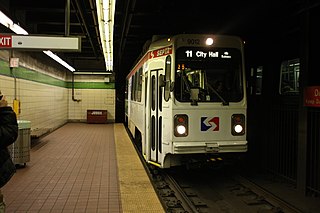
The SEPTA subway–surface trolley lines are a collection of five SEPTA trolley lines that operate on street-level tracks in West Philadelphia and Delaware County, Pennsylvania, and also underneath Market Street in Philadelphia's Center City. The lines, Routes 10, 11, 13, 34, and 36, collectively operate on about 39.6 miles (63.7 km) of route.
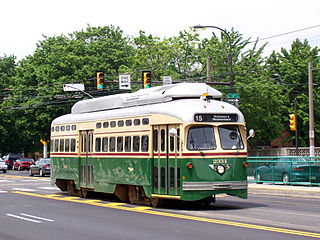
Route 15, the Girard Avenue Line, is a trolley line operated by the Southeastern Pennsylvania Transportation Authority (SEPTA) along Girard Avenue through North and West Philadelphia, Pennsylvania, United States. As of 2007, it is the only surface trolley line in the City Transit Division that is not part of the Subway–Surface Trolley Lines. SEPTA PCC II vehicles are used on the line.

The Shore Line Trolley Museum is a trolley museum located in East Haven, Connecticut. Incorporated in 1945, it is the oldest continuously operating trolley museum in the United States. The museum includes exhibits on trolley history in the visitors' center and offers rides on restored trolleys along its 1.5 mi (2.4 km) track as the Branford Electric Railway. In addition to trolleys, the museum also operates a small number of both trolleybuses and conventional buses.
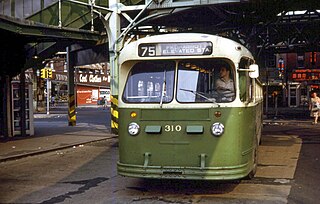
Arrott Transportation Center is an elevated rapid transit station and bus station serving SEPTA's Market–Frankford Line and City Bus routes. It is located at the intersection of Frankford Avenue, Oxford Avenue, Arrott Street, Paul Street, and Margaret Street in the Frankford neighborhood of Northeast Philadelphia, Pennsylvania. The terminal was originally known by two separate names, Margaret–Orthodox station for the Market–Frankford Line and Arrott Bus Terminal for bus routes.
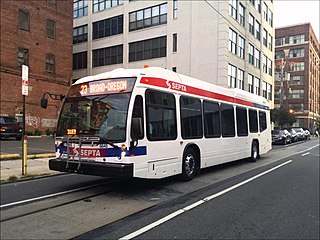
The City Transit Division of the Southeastern Pennsylvania Transportation Authority (SEPTA) operate almost all of Philadelphia's public transit, including all six trolley, three trackless trolley, and 70 bus lines within city limits. Some of the bordering municipalities are served by the City Transit division, despite not being part of the city. For example, Cheltenham Township has 13 city division routes and no Suburban Division ones. The City Transit division also operates the 400 Series routes which are designed to serve students attending schools in the city of Philadelphia.
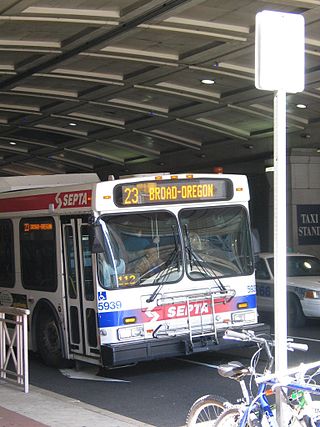
SEPTA Trolley Route 23 is a former streetcar line now operated with buses. It is operated by the Southeastern Pennsylvania Transportation Authority (SEPTA) in Philadelphia, Pennsylvania, United States. The line runs between the Chestnut Hill and Center City neighborhoods via Germantown Avenue, 11th, and 12th Streets.

SEPTA Route 75 is a trackless trolley route operated by SEPTA in North and Northeast Philadelphia, Pennsylvania, United States. It connects to the Market–Frankford Line at Arrott Transportation Center Station, and runs primarily along Wyoming Avenue. Route 75 connects to the Wyoming local line and goes to Wayne Junction in Nicetown.

SEPTA Route 59 is a trackless trolley line operated by SEPTA that runs from the Market–Frankford Line at Arrott Transportation Center Station to Bells Corner in Rhawnhurst, primarily along Oxford and Castor Avenues. Major stops along the route include Oxford Circle and the Alma Loop in Castor, which is near a shopping center and a junior high and senior high school.

SEPTA Route 66 is a trackless trolley route in Northeast Philadelphia, Pennsylvania, United States. It connects the Market–Frankford Line at the Frankford Transportation Center to Wissinoming, Mayfair, Holmesburg, and Torresdale along Frankford Avenue, which is US 13 and includes the historic, colonial Frankford Avenue Bridge.

SEPTA Route 29 is a former streetcar and trackless trolley line and current bus route, operated by the Southeastern Pennsylvania Transportation Authority (SEPTA) in South Philadelphia, Pennsylvania, United States. The line runs between the Gray's Ferry neighborhood and the vicinity of Pier 70 along the Delaware River.

The San Francisco trolleybus system forms part of the public transportation network serving San Francisco, in the state of California, United States. Opened on October 6, 1935, it presently comprises 15 lines, and is operated by the San Francisco Municipal Railway, commonly known as Muni, with around 300 trolleybuses. In San Francisco, these vehicles are also known as "trolley coaches", a term that was the most common name for trolleybuses in the United States in the middle decades of the 20th century. In 2022, the system had a ridership of 33,664,000, or about 108,200 per weekday as of the fourth quarter of 2022.

The Seattle trolleybus system forms part of the public transportation network in the city of Seattle, Washington, operated by King County Metro. Originally opened on April 28, 1940, the network consists of 15 routes, with 174 trolleybuses operating on 68 miles (109 km) of two-way parallel overhead lines. As of the fourth quarter of 2022, the system carries riders on an average of 35,400 trips per weekday, comprising about 18 percent of King County Metro's total daily ridership. At present in Seattle, a very common alternative term for trolleybus is trolley.

The Philadelphia trolleybus system forms part of the public transportation network serving Philadelphia, in the state of Pennsylvania, United States. It opened on October 14, 1923, and is now the second-longest-lived trolleybus system in the world. One of only five such systems currently operating in the U.S., it presently comprises three lines, and is operated by the Southeastern Pennsylvania Transportation Authority (SEPTA), with a fleet of 38 trolleybuses, or trackless trolleys as SEPTA calls them. The three surviving routes serve North and Northeast Philadelphia and connect with SEPTA's Market–Frankford rapid transit line.

33 Ashbury/18th Street is a trolleybus line operated by the San Francisco Municipal Railway. The route is descendant from the first trolleybus service to open in San Francisco.



















